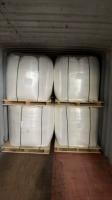Our Products
Polyacrylamide / Anionic polyacrylamide(LTP609) for construction bored piling

Anionic polyacrylamide(LTP609) for construction bored piling
Building piling is mainly used in molecular weight of more than 18 million, degree of hydrolysis in about 25 copolymerization of anionic polyacrylamide. Chinafloc has extensive experience in the application of anionic polyacrylamide in building piling, and its products are exported to Vietnam, Germany, India and other regions.
The hydrophobic monomers were dispersed in the continuous phase in the form of mixed micelles or sol-increasing, and the active end of the continuous phase was extended into the micelles to induce the hydrophobic monomers in the micelles to participate in graft copolymerization. To achieve micelle graft copolymerization with hydrophobic monomer.
The copolymerization mechanism produces free radicals under radiation, and the rupture mainly occurs on tertiary carbon, because the hydrogen atoms on tertiary carbon are more easily excited than those on secondary carbon. Then the free radical reacts with the reactive monomer, gradually forming the macromolecule grafted side chain, and the free radical performs addition reaction with a small monomer molecule.
Graft copolymerization process of anionic polyacrylamide for pile driving on adhesive tape. Firstly, the water-solubility of anionic polyacrylamide is dispersed in water phase. The chain radicals are then repressed in the homogeneous region of the solution. The monomer, copolymerized with it, forms a branch chain on the molecular chain; Macromolecular free radicals collide with hydrophobic monomers in sol-increasing bundles and initiate polymerization of hydrophobic monomers in micelles, thus introducing hydrophobic segments and forming branch chains or connecting to branch chains on molecular main chains. When the polymerization of anionic polyacrylamide was finished, the main molecular chain was grafted to copolymerized branch chain, and finally formed the molecular structure of block shaped branch chain.
The polymer obtained by copolymerization of anionic polyacrylamide with pile driving is comb polymer. Comb polymer is in the same side of the polymer main chain, regular and equidistant grafting of the same chain length side chain, forming a polymer like a comb structure. The hydrophobic modified water-soluble polymers prepared by introducing hydrophobic groups into the hydrophilic polymer chain are called comb type. The random distribution of the hydrophobic side groups of the comb leads to the hydrophobic association occurring between molecules and within molecules. When the concentration of polymer is low, hydrophobic association is mainly intramolecular: when the concentration of polymer is high, the probability of intermolecular association increases, and the polymolecular chain aggregates formed by intermolecular association increase the hydromechanical volume of polymer chain and increase the apparent viscosity of aqueous solution. When the mass dosage of anionic polyacrylamide monomer was more than 3.9%, the water-solubility of the graft product was poor, mainly because the water-solubility of the graft product decreased when the content of hydrophobic groups in the graft product exceeded a certain value. The continuous increase of the amount of hydrophobic monomer will lead to hydrophobic modified polyacrylamide is difficult to dissolve in water, so the content of hydrophobic monomer must be strictly controlled. It can be seen that with the increase of the amount of hydrophobic monomer, the apparent viscosity of micelle grafted product in aqueous solution increased first and then decreased. The amount of feed has a great influence on the apparent viscosity of the aqueous solution.
The anionic polyacrylamide polymers used for piling will degrade and cross-link simultaneously when exposed to radiation, but one of them plays a dominant role in a certain range of radiation doses. PAM is a crosslinking polymer, and crosslinking plays a leading role. There are several different types of polymer radiation crosslinking: pile driving anionic polyacrylamide intramolecular crosslinking, that is, different chain segments within the same molecular chain, between groups can be linked to form internal crosslinking; Pile polyacrylamide chemical bond, that is, the formation of chemical bonds between polymer chains and polymers of additive molecules; Pile driving anionic polyacrylamide intermolecular crosslinked bonds formed by the recombination of intermolecular chain radicals. Polyacrylamide molecular chain has the same number of units as acrylamide side group - amide group, and amide group has high polarity, easy to form hydrogen bonds and high reactivity. Under the radiation condition of anionic polyacrylamide used for piling, active groups were generated on amide groups and amidation crosslinking reaction occurred between molecular chains. When the radiation time is short, the polymer will undergo imide crosslinking reaction of amide group and produce branch chain, which is manifested as the increase of apparent viscosity of aqueous solution. With the further extension of radiation time, the increase of crosslinking links gradually forms regional network structure, and finally forms three-dimensional crosslinking network, which is manifested as insoluble in water. Crosslinked polyacrylamide is insoluble in water but absorbs large amounts of water to form a gel. The experimental results show that PAM is a radiation crosslinking polymer, and crosslinking plays a leading role in the radiation process.



963_small.jpg)

